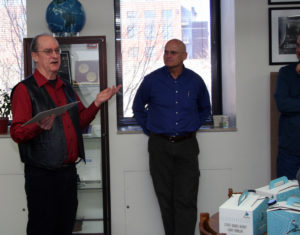SSEC computer scientist Tom Whittaker wins American Meteorological Society award
Longtime UW-Madison Space Science and Engineering Center (SSEC) researcher Tom Whittaker was recognized by the American Meteorological Society (AMS) in early March with the STAC Distinguished Scientific/Technological Accomplishment and Outstanding Service Award. The award recognizes Whittaker’s outstanding and sustained contributions to atmospheric science and technology, as well as his service to the Environmental Information Processing Technologies group and the society.
When asked to reflect on his career at SSEC, Whittaker remembers clearly when and where it began. A childhood visit to a planetarium gift shop led him to a “Golden Adventure Book” on the weather, and at that moment he says, he became a true weather enthusiast.
Years later he moved from his hometown in Cleveland, Ohio to attend college at the University of Wisconsin-Madison in 1965 where he eventually got his start in the field of meteorology.
“When I got to campus, I found out I could not take any meteorology courses for two years,” he says. “Needing some credits, I looked around and found a course in something that was called ‘computer science,’ if you can believe it.”
As it turned out, he liked this new and developing field and excelled at the coursework. Whittaker’s history at SSEC can be traced back to his work with Professor Don Johnson’s group in the late 70s. There he put his computer science skills to use working on a variety of projects, among them the creation of weather plots using satellite data, part of the formative years of McIDAS (Man computer Interactive Data Access System). McIDAS was one of the first software programs developed to visualize geostationary weather data over the US. Its public debut in 1977, enabled a new kind of television weather broadcast featuring computer-generated graphics rather than the hand-drawn graphics characteristic of the day.

Retired SSEC scientist Tom Whittaker speaks at a gathering in Madison, WI after being awarded the AMS Distinguished Scientific/Technological Accomplishment and Outstanding Service Award in early March 2018.
Using this new tool, McIDAS, Whittaker teamed with Johnson again to help create some of the first distance education learning modules for the field of meteorology.
Whittaker would later merge his McIDAS work with the formation of a university consortium called UNIDATA, established in the early 80s to preserve free access to geoscience data and visualization tools. UNIDATA continues today under the University Corporation for Atmospheric Research (UCAR) Communities Program.
“One of the challenges in the early days was reliability of the computer hardware,” says Whittaker. “But as the platforms improved and more memory was added we were able to realize more complex analysis and displays and better distribute the ever-increasing volume of data.”

The first public debut of the Man computer Interactive Data Access System (McIDAS) in 1977.
By the late 90s, Whittaker coded a new program called VISITView, an online, collaborative system for training National Weather Service forecasters. The system displays visual weather animations and includes other functions, such as digital white board, zooming, colorizing and chat functions used to link instructors with their students at any location. It was a crucial service during the early days of the web and continues to be a key training system for meteorologists today.
True to the Wisconsin Idea, Whittaker’s wealth of knowledge was not isolated at SSEC, he shared his knowledge of meteorology and visualization with other atmospheric scientists through programs at the AMS. He led the Interactive Information Processing Systems (IIPS) conferences for 10 years, served on boards and organized conference events.
Officially retiring in 2005, he hasn’t stopped programming. He went on to develop a series of weather applets that could be used by teachers to show students some basic principles of meteorology and atmospheric science, like how snowflakes grow or how relative humidity changes inside your house when the outdoor temperature and dew point change.
He continues to be active in his community and volunteers as a local tutor for Madison high schools helping students with math and physics.
Whittaker can still be seen roaming around SSEC visiting colleagues and keeping up on the latest developments at the center. He’s encouraged by the advances in geostationary satellites and ways they’ve evolved for other uses like detecting wildfires, air turbulences, and volcanic ash.
“When you’re here so long, you get to know people and they become like an extended family. And I’m grateful for the strong relationships we’ve developed over the years.”
By Eric Verbeten
